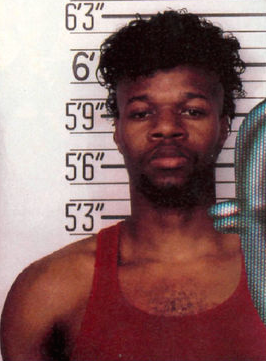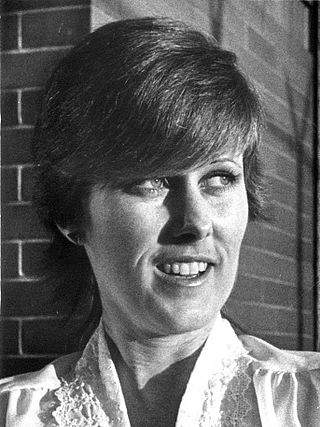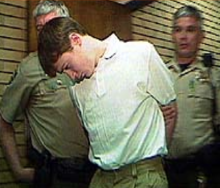
Christopher J. Scarver Sr. is an American convicted triple-murderer who is best known for the murders of his fellow inmates Jeffrey Dahmer, a serial killer, as well as Jesse Anderson, a murderer, at the Columbia Correctional Institution in Wisconsin in 1994. Scarver used a 20-inch (51 cm) metal bar which he had removed from a piece of exercise equipment in the prison weight room to beat and fatally wound Dahmer and Anderson. Scarver was sentenced to two further life sentences for the murders of Dahmer and Anderson, after being sentenced to life in prison for the murder of Steve Lohman in 1990.

Matricide is the act of killing one's own mother.
The Rocori High School shooting was a school shooting that occurred at Rocori High School on September 24, 2003 in Cold Spring, Minnesota, United States. The shooter was identified as 15 year-old freshman John Jason McLaughlin, who murdered 14-year-old freshman Seth Bartell and 17-year-old senior Aaron Rollins. Prior to the shooting, McLaughlin was described as "quiet and withdrawn".
The Frontier Middle School shooting was a school shooting that occurred on February 2, 1996, at Frontier Middle School in Moses Lake, Washington, United States. The gunman, 14-year-old Barry Dale Loukaitis, killed his algebra teacher and two students, and held his classmates hostage before a gym coach subdued him.
A school shooting occurred on November 8, 2005 at Campbell County Comprehensive High School in Jacksboro, Tennessee, United States, when a 15-year-old freshman student shot the school principal and two assistant principals. One assistant principal, Ken Bruce, died as a result of the shooting.
Bang Bang You're Dead is a 1999 one-act play written by William Mastrosimone. Inspired by the Thurston High School shooting, the play follows a high school shooter who is tormented in his jail cell by apparitions of the five classmates he killed. A film adaptation, also written by Mastrosimone was released in 2002; it depicts a high school production of the play where one of the actors struggles to avoid becoming a shooter like the play's lead character.
The Heath High School shooting occurred at Heath High School in West Paducah, Kentucky, United States, on December 1, 1997. 14-year-old Michael Carneal opened fire on a group of students, killing three and injuring five.

Thurston High School is a public high school located in the Thurston area of Springfield, Oregon, United States.
The Pearl High School shooting was a school shooting that occurred on October 1, 1997 at Pearl High School in Pearl, Mississippi, United States. The gunman, 16-year-old 11th grade student Luke Woodham, shot and killed two students and injured seven others at the school after killing his mother by bludgeoning at their home earlier that morning.

Elizabeth Diane Downs is an American criminal who murdered her daughter and attempted to murder her other two children near Springfield, Oregon on May 19, 1983. Following the crimes, she made claims to police that a man had attempted to carjack her and had shot the children. She was convicted in 1984 and sentenced to life in prison plus fifty years. She briefly escaped in 1987, but was quickly recaptured. Downs has been repeatedly denied parole and psychiatrists have diagnosed her with narcissistic, histrionic, and antisocial personality disorders, with one labelling her as a "deviant sociopath."

Lawrence Fobes King, also known as Latisha King was a 15-year-old student at E.O. Green Junior High School in Oxnard, California, who was shot twice by a fellow student, 14-year-old Brandon McInerney, and kept on life support until two days later.
On March 24, 1998, a school shooting occurred at Westside Middle School in unincorporated Craighead County, Arkansas near the city of Jonesboro. Perpetrators Mitchell Johnson, 13, and Andrew Golden, 11, fatally shot four students and a teacher with multiple weapons, and both were arrested when they attempted to flee the scene. Ten others were wounded. Golden and Johnson were convicted of five murders and ten assaults, and were imprisoned until each turned 21 years of age. After the 1992 Lindhurst High School shooting that killed four people in Olivehurst, California, the massacre was the deadliest non-college school shooting in contemporary U.S. history until the April 1999 Columbine High School massacre. As of 2023, it is currently the deadliest middle school shooting in U.S. history.
The Bethel Regional High School shooting was a school shooting that occurred on February 19, 1997, at Bethel Regional High School in Bethel, Alaska. Two people were killed and two people were wounded by 16-year-old student Evan Ramsey. Ramsey is serving two 99-year prison sentences and will be eligible for parole in 2066 when he is 85.
Rick Dancer is an American journalist and politician in the state of Oregon. Born in the city of Hillsboro, he was a longtime anchor for KEZI television in Eugene. Among his other activities as anchor, he covered the Thurston High School shooting. He later left broadcasting to run as a Republican for Oregon Secretary of State, losing in the general election to Democrat Kate Brown in 2008.
Daniel Petric is a convicted murderer from Wellington, Ohio. At age 16, he shot both of his parents after his father confiscated his copy of the video game Halo 3. His mother died, but his father managed to recover from a critical injury. He is incarcerated for life, with a chance for parole. Studies of video game addiction or the effects of violent video games on society, as well as gun control, often mention Daniel Petric.

Jared Lee Loughner is an American mass murderer who pled guilty to 19 charges of murder and attempted murder in connection with the January 8, 2011, Tucson shooting, in which he shot and severely injured U.S. Representative Gabby Giffords, and killed six people, including Chief U.S. District Court Judge John Roll, Gabe Zimmerman, a member of Giffords' staff, and a 9-year-old girl, Christina-Taylor Green. Loughner shot and injured a total of 13 people, including one man who was injured while subduing him.
On the morning of February 27, 2012, six students were shot at Chardon High School in Chardon, Ohio, resulting in the deaths of three of them. Witnesses said that the shooter had a personal rivalry with one of his victims. Two other wounded students were also hospitalized, one of whom sustained several serious injuries that have resulted in permanent paralysis. The fifth student suffered a minor injury, and the sixth a superficial wound.
On April 2, 2012, a gunman opened fire on people inside Oikos University, a Korean Christian college in Oakland, California, United States, killing seven people and injuring three others. One L. Goh, a former student at the school, was taken into custody and identified as the suspect in the shooting. It is the deadliest mass killing in the city's history.

James Eagan Holmes is an American mass murderer responsible for the 2012 Aurora, Colorado shooting in which he killed 12 people and injured 70 others at a Century 16 movie theater on July 20, 2012. He had no known criminal background before the shooting occurred. Before the shooting, Holmes booby-trapped his apartment with explosives, which were defused one day later by a bomb squad.
The Marshall County High School shooting was a mass shooting that occurred at Marshall County High School near Benton, Kentucky, on January 23, 2018. The gunman, 15-year-old student Gabe Parker, opened fire in an open area at the school, murdering two students and injuring 14 others.









